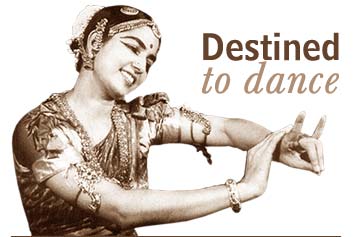Home > News > Specials
The Rediff Special/Shobha Warrier
February 27, 2004

Rukmini Devi Arundale, danseuse par excellence, believed destiny and divine power played a major role in her life. Otherwise, her father, an engineer with the Public Works Department, would not have joined the Theosophical Society movement after being influenced by Annie Besant.
It was because her father came to live near the Theosophical Society at Adyar, Madras (now known as Chennai), that she met her husband, Dr George Arundale, who was a close associate of Annie Besant. Their marriage, which took place with her blessing, sent shock waves through conservative Madras. But, even at the tender age of 19, Rukmini Devi believed in living by her convictions.
She travelled all over the world with Dr Arundale. It was during one of these trips that she met the legendary dancer Anna Pavlova. Noticing her interest in dance, Pavlova asked her to start learning the art form.
Rukmini Devi was in her late twenties at the time. She gave Pavlova's suggestion serious consideration. After returning home, she brought the legendary Meenakshisundaram Pillai to Madras and began learning Bharata Natyam from him. Once again, Madras' conservative Brahmin society was shocked. Till then, no Tamil Brahmin had ever danced! But Rukmini Devi was destined to be a path-breaker.
It was her husband who suggested she start a dance academy. He believed art would be a good tool through which the message of the Theosophical Society could be spread.
Kalakshetra, which adopted the gurukul system (where students stayed at the academy until their education was complete), was born within the grounds of the Theosophical Society. Rukmini Devi sought dancers, musicians and artistes from all the traditional art forms to teach her students. Luckily for her, and for art as a whole, none of the great artistes who subsequently worked with her were concerned about money. Sankara Menon, for example, who was earning Rs 300 as a research scholar at Madras University joined Kalakshetra as its principal for half that amount.
 Initially, Rukmini Devi found it difficult to find students as it was believed that 'girls from good families did not dance'. This did not faze her. She began by teaching her brother's daughter, Radha (Burnier, who went on to head the Theosophical Society of India). Leelavathi became her second student. Rukmini Devi also trained Sarada (Hoffman), daughter of the headmaster of a nearby school.
Initially, Rukmini Devi found it difficult to find students as it was believed that 'girls from good families did not dance'. This did not faze her. She began by teaching her brother's daughter, Radha (Burnier, who went on to head the Theosophical Society of India). Leelavathi became her second student. Rukmini Devi also trained Sarada (Hoffman), daughter of the headmaster of a nearby school.
She even sent people in search for students. That is how the brothers Raman and Lakshmanan (now known as Adyar Lakshmanan) joined Kalakshetra. When she began looking out for a promising student whom she could train in the dance form, Kathakali, Chandu Panikkar brought Dhananjayan and Balagopal from Kerala. Among the early students at Kalakshetra, they trained directly under Rukmini Devi and other great masters.
Rukmini Devi travelled all over the world with her students, performing dance dramas she had composed. This was another revolutionary step. Her famous dance dramas included Kutrala Kuruvanji, Sita Swayamvaram, Ramayana, Kumara Sambhavam, Gita Govindam and Usha Parinayam. 'Many people have said many things about my being a pioneer. I can only say I did not consciously go after dance. It was dance that found me,' she once said.
Rukmini Devi was like a banyan tree that sheltered and encouraged growth. 'Looking back, I can clearly see a Divine Power which has directed and taken control of my life. I do not consider that it was my work alone or even the dedication of my workers that has built Kalakshetra. It is remarkable how every time a door was closed to us, another opened. Whenever we were faced with difficulties and we thought the last day had come, somehow the work survived. Not only has it survived; it has grown. Grown far beyond what I had planned. That is why I feel that there is a Divine Will. Work which is blessed can never die,' wrote Rukmini Devi Arundale.
Her students now prepare to pay her a tribute at Kalakshetra -- Rukmini was born on February 29, 1904 and passed into the ages in 1986 -- on her 100th birth anniversary. The tribute will begin with a prayer meeting under the banyan tree she planted 54 years ago.
Three of her earliest students shared their memories of Rukmini Devi with rediff.com
Don't forget to log in and read these features:
Shanta Dhananjayan: 'Rukmini Devi was a banyan tree under whom everyone flourished'
Krishnaveni Lakshman: 'She moulded us into good human beings'
Adyar K Lakshmanan: 'No one can take her place'
Image: Uday Kuckian